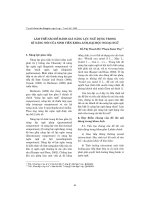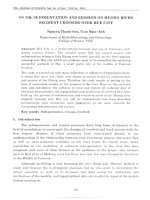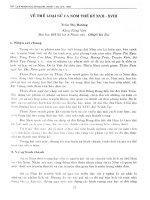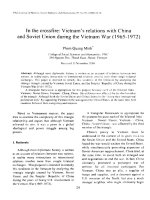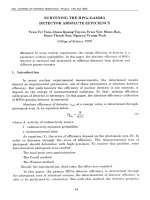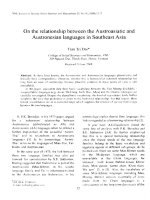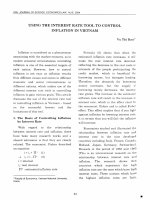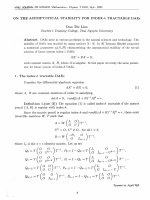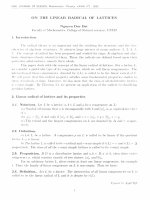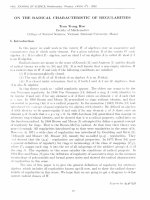DSpace at VNU: Determining the effective uniaxial modulus of three - phase composite material of aligned fibres and spherical particles
Bạn đang xem bản rút gọn của tài liệu. Xem và tải ngay bản đầy đủ của tài liệu tại đây (2.64 MB, 7 trang )
V N U . J O U R N A L OF SC IEN CE, M a th e m a tic s - Physics. T .X X II, N q 3 - 2006
D E T E R M IN IN G
T H E E F F E C T IV E U N IA X IA L M O D U L U S
O F T H R E E -P H A S E
A L IG N E D
C O M P O S IT E M A T E R IA L O F
F IB R E S A N D S P H E R IC A L P A R T IC L E S
N g u y e n D in h D uc^1), H o a n g V a n T u n g (2)
w Vietnam National University, Hanoi
Hanoi Architectural University, Vietnam
Composite m a t e r i a l is w i d e l y u s e d in m o d e r n s t r u c t u r e s a n d t h e li f e t h a n k
to its advantages. In fact, one has investigated and applied many kinds of three-phase
composite material obtained by embedding spherical inclusions into the matrix phase
of fibre reinforced material. Seeking solutions for the effective properties of threephase composite including matrix phase and two other phases, which are spherical
particles, has been given in [2]. Basing on algorithm introduced in [2], we have deriven
three-phase problem into two two-phase problems and determined the uniaxial mod
ulus of three-phase composite composed of matrix phase, aligned fibres and spherical
inclusions. By calculating results for a specific three-phase composite, this paper
has given conclusions about the influence of third phase (spherical particles) on the
performance of structures.
A bstract.
1.
S e ttin g p r o b le m
Com posite m aterial of aligned fibres are thought to have cyclic structure, therefore,
studying this kind of m aterial leads us to considering a representative volume element
among those cyclic structures. Here, representative volume element has form of a rectan
gular parallelepiped. According to composite cylinders model, the fibre phase is taken to
be composed of infinitely long circular cylinders em bedded in a continuous m atrix phase.
W ith each individual fibre of radius a, there is associated an annulus of m atrix m aterial of
radius b. Each individual cylinder com bination of this type is referred to as a composite
cylinder. In three-phase model, one embeds spherical inclusions which are isotropic hom o
geneous elastic spheres of equal radii into m atrix phase. Consequently, present problem
can be posed as follows.
Fig. 1. T he representative volume element of fibre reinforced m aterial
and com posite cylinder model
Typeset by .AjVfS-TfeX
12
D e t e r m i n i n g the e ffe c tiv e u n ia x ia l m o d u lu s o f ...
13
Let us consider a heterogeneous cylinder consisting of inner portion (0 •< r
outer portion (a
a) and
r -< b). T he composed m aterials are isotropic homogeneous elastic of
properties (Àa,Ma) and (Am,/xm), respectively. T here exist an assum ption th a t association
between m atrix phase and fibre phase is ideal, therefore, th e uniaxial strain of two portions
are the same.
In this case, three-phase composite m aterial is obtained by embedding
isotropic homogeneous spheres having the same radius and elastic characteristics (AC,/2C)
into the continuous m atrix phase of aligned fibre-reinforced m aterial. O ur present objective
is th a t determ ine the effective uniaxial m odulus EỊỵ of three-phase com posite as a function
of the elastic properties of constituents as well as the volume fractions of th e inclusions.
2.
G o v e rn in g r e la tio n s
It is easy to recognise th a t investigating problem will become more convenient if
governing relations are given in a cylindrical coordinate system [3 ].
Because of symmetry, assum e the following displacem ent field:
u r = u r {r) , UQ = 0 , u z = e z .
(1)
Strain components are defined, respectively
dur
Ì €-69
dr
ur
J &ZZ — £ •
r
(2)
In this case, the system of equilibrium equations has simple form
dơ J'y
ơrr &60
dr +
r
=
0.
(3)
By Hooke’s laws, equation (3) is expressed in term s of the displacem ent field as follows.
d r2
r dr
r ^ Uj"
(4 )
3. S o lu tio n m e th o d
As mentioned above, governing idea for solving present three-phase problem is th a t
converting it into two two-phase problem s.
Firstly, we combine original m atrix phase
and particle phase in order to give a new m atrix phase called effective m atrix phase. In
fact, this effective m atrix phase is a spherical particle-reinforced m aterial of which elastic
properties have been defined by some researchers, such as [1] and [5].
T hen we seek
solution for the effective properties of fibre-reinforced com posite m aterial composed of the
N g u y e n D in h D u e , H oang V an Tung
14
effective m atrix phase and aligned fibres. M ethod for determ ining the elastic m oduli of
aligned fibre-reinforced m aterial has been mentioned in [1]. Basing on th a t m ethod, we
have specifically defined the effective uniaxial modulus of two-phase composite of aligned
fibres.
It is very im portant to emphasize th at process of converting a three-phase model
into two-phase models must seriously been performed. Specifically, we can not combine
initial m atrix phase and the fibre phase in order to obtain the effective m atrix phase. This
fundamentally differ from three-phase model given in [2], where composite m aterial is
composed of m atrix phase and two particle phases made of two different kinds of m aterial.
3.1. T h e tw o -p h a se m o d e l
Let us consider two-phase composite consisting of isotropic m atrix phase and isotropi'
fibre phase having properties (Am, fim) and (Aa, /xa), respectively. T hen the effective uni
axial modulus of the two-phase composite is defined according to composite cylinders
model [1 ] as follows.
$.1.1. Part of matrix phase
In the part of m atrix phase (a ^ r ■< b) the solution of eq. (4) is in form
u^ =
A2V + — .
r
(5)
By Hooke’s laws, stress field is defined
ơ $ = 2(À2 + /42 M 2 — 2/Z2 2~ + ^ 2e'
After defining integration constants due to boundary and interface conditions
= 0
r=b
,
ơ r( 2r )
r=a
p ,
(7 )
vherep is interaction stress on the interface of fibre and m atrix phases), the displacement
idd in the part of m atrix phase is determined as follows.
pa 2
2 (a 2 —b2)(X 2 + /Ì2)
A2s
2(A2 + /Ì2) r
pa2b2
7{a2
2 -_ 0- ) o
2 /i 2 r
1
( )
3.1.2. Part of fibre phase
In this part (0 -< r ■< a), the displacement and stress fields have the form of
u l1^ = A i r ,
(9)
(,
D e t e r m i n i n g the effe ctive u n ia x ia l m odulus o f ...
15
(10)
ơ!£) = 2(Ai + ụ>i)Ai + Ai £.
Specifying the integration constant A \ from the interface
(1)
p ,
r=a
gives US
,(1 ) =
p~ x
2(Ai + H i )
(1 1 )
The interaction stress p is defined from continuity condition
u (1 )
r=a
as follows
^ 2(AiM2 - A2M1 )(a2 - b2)e
p=
(13)
/i 2 (A2 + ụ-2)(a 2 - fr2) - (Ai + Ail) L 2a 2 + (A2 + M2) ^
3.1.3. The composite cylinders model
According to this model, the effective uniaxial module of fibre-reinforced material
is determ ined as follows
1
-ềiỊỊ
£ 11 =
7xb2e
s
where
Si
IJc T ™ d S + J ị ơ g d S
S\
(13)
S2
= 7Ta2, s*2 = 7r(b2 — a 2), 5 = 7TÒ2 are the cross-section areas of fibre phase,
m atrix phase and composite cylinder, respectively.
By Hooke’s laws, the uniaxial stresses of phases are defined
» U ) - ( A 1 + 2t o k + ^ Ai£ f+ M
Hi
ơ zz
— ( ^ 2 + 2/X2 ) ^ +
(li)
-
pa‘
A2
- À2Ê
A2 + ịi2 .a2 — b2
(15)
Introduction (14), (15) into (13) taking into account ( 12 ), we obtain the following relaticn
■ E ll — £ a . E a +
(1 -
ia )E m
4 ia (l
+
(1 -
da)G m ( K a +
G J 3 ) - 1 + £ a ơ m ( K m + G m / 3 ) _1 +
(16)
1 ’
where f a = a 2/ 62 is the volume fraction of fibre phase.
Expression (16) is a form ula for determining the effective uniaxial modulus of twophase composite m aterial of aligned cylindrical fibres.
N g u y e n D in h D u e , H oang Van Tang
16
3 .2 . T h e th re e-p h a se m o d e l
Now we embed spherical particles having the same radius and elastic properties
(Ac
, ALc) into the m atrix phase of aligned fibre-reinforced material. Then we combine
initial m atrix phase and particle phase in order to give new m atrix phase called effective
m atrix phase. In fact, this effective m atrix phase is spherical particle-reinforced isotropic
material of which properties have been determined by Hasin and Christensen [1] as follows
nie)
—Q
rn
^ 1
K {e) = K
"
_
15(1 - l/m ) (1 - G c / g m K c
K m)£c_________
J__________ (ifc
m
(17)
7 —5um + (8 — 10Vm)Gc/Gr
1 + (K c - K
,
,
rn) ( K m + 4 G m / 3 ) - 1 '
where £c is the volume fraction of particle phase.
Substituting the elastic characteristics of m atrix phase in equation (16) by their
effective values (17) and (18), we obtain the following relation
E'n = ZaE* + (1 - Za)El
^4a £
Va
- L( l“- &
< * a)) \( "va a—- v
" mt f )Ị 2 G\
+ -------------- -------------------------------------------------- ------ - 1------ ,
+1
(1 - i a ) G # ( K a +I r*
G a //o\~
3 ) - 11 +I Zc a/^»(e)
G m (( k £ + G # / 3 )
where
Qz<^(e)/^(e)
ỵp(e) _
~
y^-rn
Q
_ 9 /7 (5 )
0I\m
_ onto'
(e) _ olx-rn
Oi\rn II /-(f)
v^rn ’
~
(19)
Expression (19) is a formula for determ ining the effective uniaxial modulus of three-phase
composite m aterial composed of continuous m atrix phase, aligned fibres and spherical
particles.
Obviously, this modulus is a function of the elastic properties and volume
fractions of constituents.
For example, we consider a three-phase composite m aterial having the following
characteristics: M atrix phase is made of epoxy having properties Em = 0, 315.106( k G /c m 2)
i/m = 0,382, whereas, fibre and particle phases are made of glass having elastic moduli
E a = E c = 7,4.106(k G /c m 2) , va = vc = 0,21 in constant relation of volume fractions
£a + <£c = 0,6.
Calculating results for the effective uniaxial module E h according to formula (19)
are given in below table and sketched in figure 2 .
£a
0
E [x. 1(T 6 0,6842
0,1
0.2
0,3
0,4
0,5
0,6
1,3014
1,9305
2,5716
3,2247
3,8899
4,5672
D e t e r m i n i n g the effective un iaxial m odulus o f .
17
the volume fraction of fibre phase
Fig. 2. The variance of the effective uniaxial modulus
according to the volume fractions of constituents.
4. C o n c lu sio n s
a) Converting three-phase model into two-phase models is reasonable. We have deter
mined the effective uniaxial modulus of three-phase composite consisting of m atrix
phase, aligned fibres and spherical particles. Solving three-phase problem lead us
to two two-phase problems. First problem is solved in order to define the effective
elastic moduli of spherical particle-reinforced material.
According to composite
cylinders model, second one is solved for determining the effective elastic moduli of
composite m aterial composed of effective m atrix phase and fibre phase.
b) Embedding spherical particles as third phase into the continuous m atrix phase of
aligned fibre-reinforced m aterial to reduce the effective uniaxial modulus of this kind
of m aterial. Therefore, if structure is subjected to axial forces, it is necessary to
consider embedding spherical particles into m atrix phase of aligned fibre-reinforced
m aterial.
N g u y e n D in h D u e , H oang Van T an g
18
The results of researching presented in the paper have been performed according to
scientific research project of Hanoi National University, coded QT.06.48 and have partly
been supported by the National Council for N atural Sciences.
R e fe re n c e s
1. R. M. Christensen, Mechanics of Composite Materials, John Wiley and Sons Inc,
New York, 1979.
2. Nguyen Dinh Due, Three-phase polymer nanocom posite m aterial, Journal of Sci
ences, Mathematics-Physics, VNU, T.XXI, No3(2005).
3. Dao Huy Bich, The theory of elasticity, T he Publishing House of Vietnam National
University, Hanoi, 2001.
4. Nguyen Hoa Thinh, Nguyen Dinh Due, The Composite Material - Mechanics and
technology, The Publishing House of Science and Technique, Hanoi, 2002.
5. Nguyen Dinh Due, Hoang Van Tung, Do T hanh Hang, A m ethod for determining
the module K of Composite m aterial with sphere pad seeds, Journal of Science,
Mathematics-Physics, VNU, T.XXII, N ol(2006).
